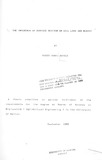| dc.description.abstract | The study was conducted on sixteen runoff plots installed at the erosion control research station, Department of Agricultural Engineering, at the Kabete Campus of the University of Nairobi, on a 16.4% slope of a humic nitosol, to assess the effect of surface scattered maize residue on soil loss and runoff. Four treatments, a control without residue cover and three different rates ( 0.5, 1, and 2.25
t/ha ) of maize residue were tested under natural rainfall ( two seasons ) and a 65 mra/hr intensity simulated rainfall. The levels selected were based on an estimated average residue production of 3 t/ha associated with grain yield of approximately 1.5 t/ha by most smal l holder farmers under tropical conditions. Percent ground cover provided by the different residue rates was determined using the photographic method.
Results showed that treatment effects were highly significant ( P<0.05) in reducing soil and runoff losses under all conditions of natural and simulated rainfall tests. Under all natural and simulated rainfall studies, consistent reduction in both soil and runoff losses were obtained with increased application of residue as surface cover.
Total soil loss from the control plots during the 1988 short rains, 1989 January rains and 1989 long rains was 407
t/ha, while it was 357, 323, and 299 t/ha from plots with
0. 5, t and 2.25 t/ha residue treatments respectively. Total
runoff from the control plots during the same periods was 240 mfn, while it was 214, 201 and 194 mm, from plots with 0.5,
1, and 2.25 t/ha residue treatments respectively.
Total soil loss for the three simulation runs from the control plot was 63 t/ha, while it was 51, 40, and 25 t/ha
from plots with 0.5, 1, and 2.25 t/ha residue treatments
respectively. Total runoff for the three simulation runs from
the control plots was 33 mm, while it was 30, 28, and 20 mm
from plots with 0.5, 1, and 2.25 t/ha residue treatments
respectively.
In general surface scattered crop residues were found to be more effective in reducing soil and water losses from low intensity rains than from high intensity rains and during the early part of a rainy season when soils are relatively dry ( even if high intensity rains occur ) than later in the season when soils are already saturated with antecedent rainfall.
Equations relating air dry residue weight to percent surface cover, as well as percent surface cover to soil and runoff losses were derived. Residue cover was exponentially related to both soil and runoff losses, with coefficient of determination ( r^ ) of 0.997 for soil loss and 0.970 for runoff. | |

